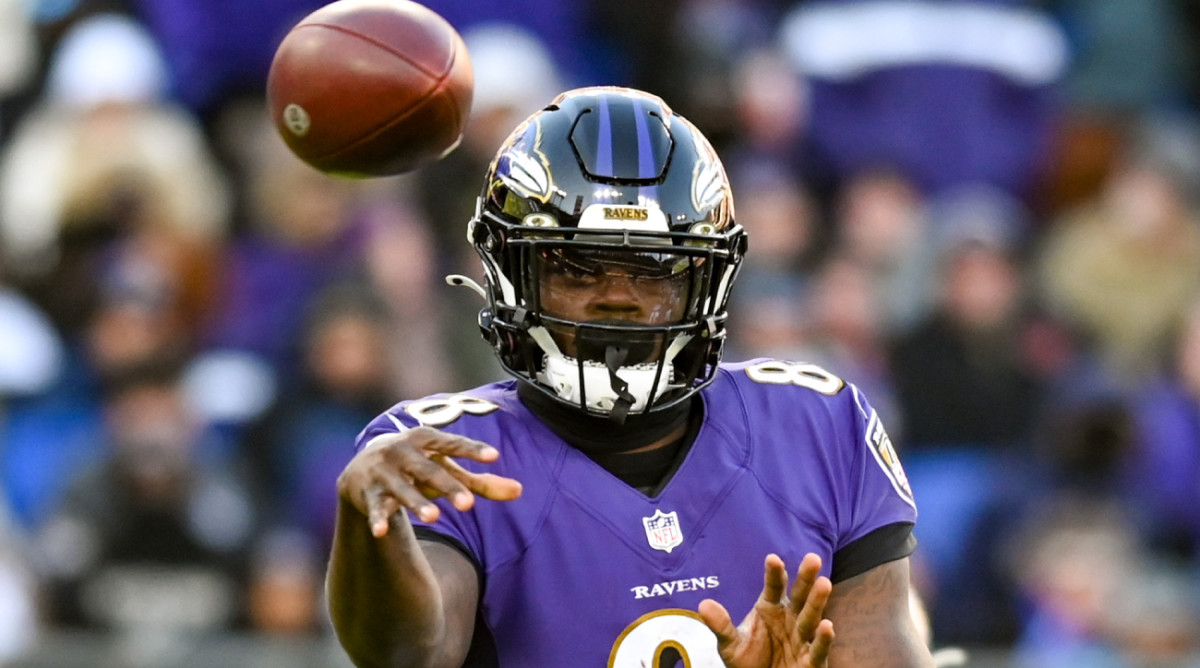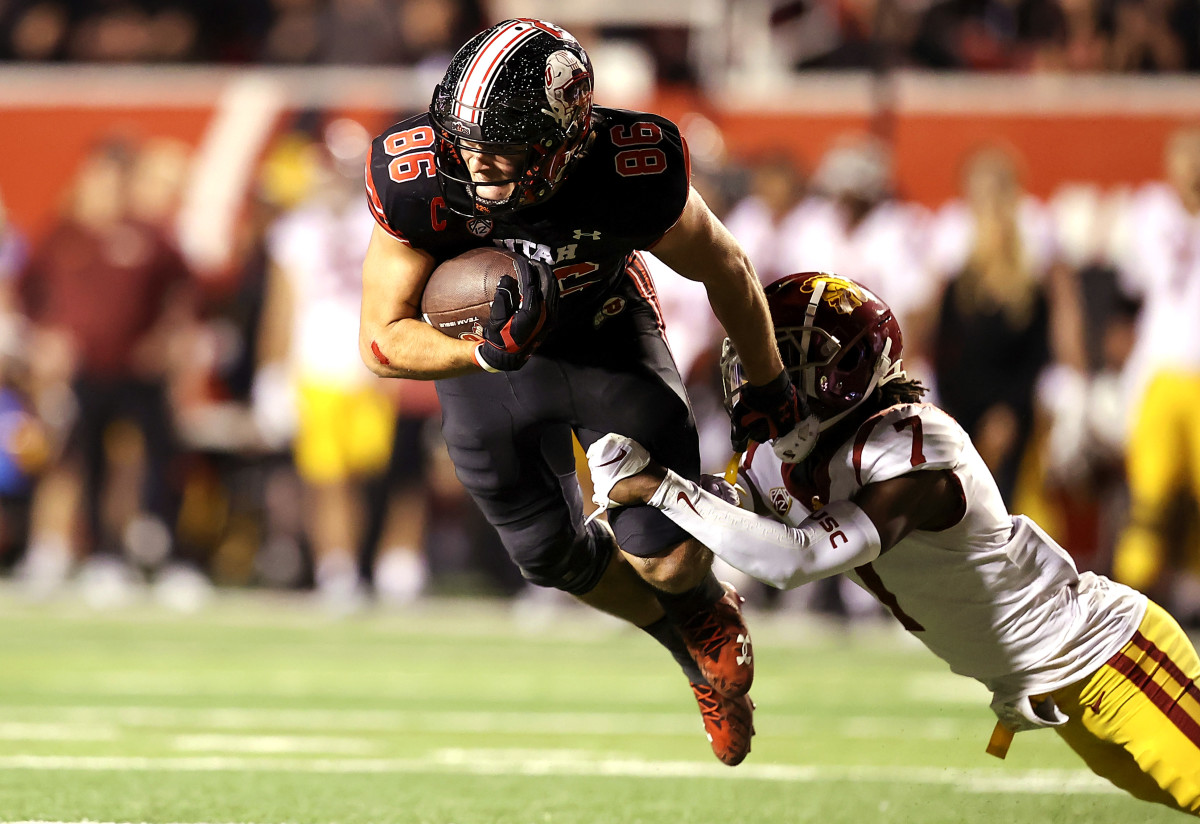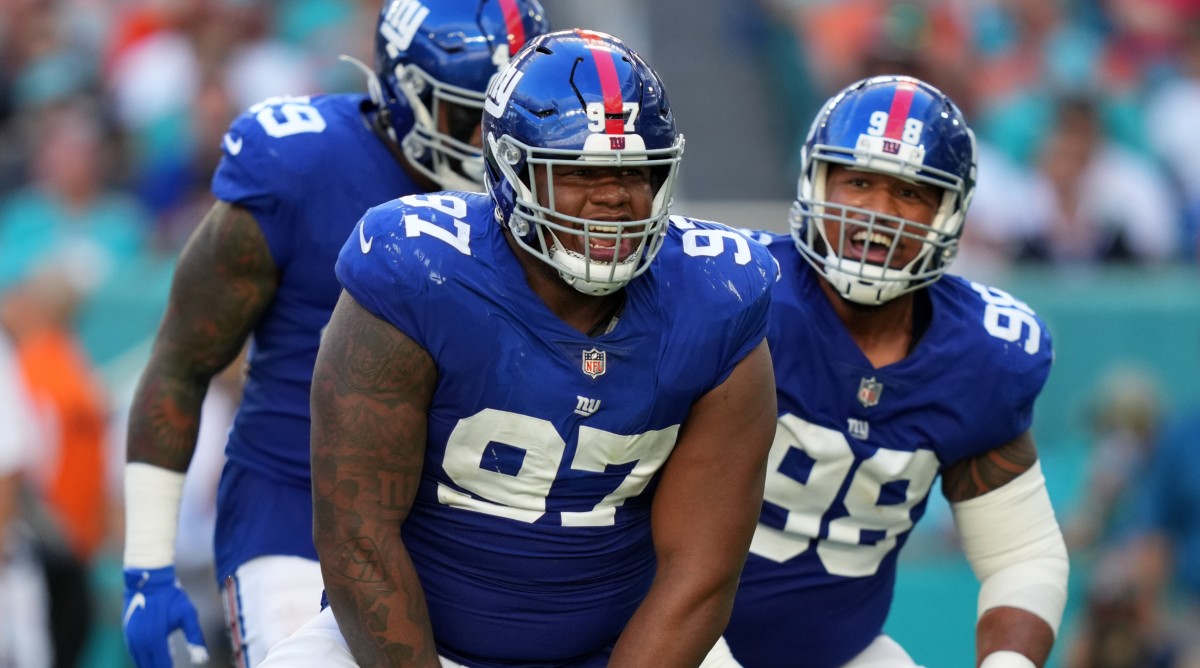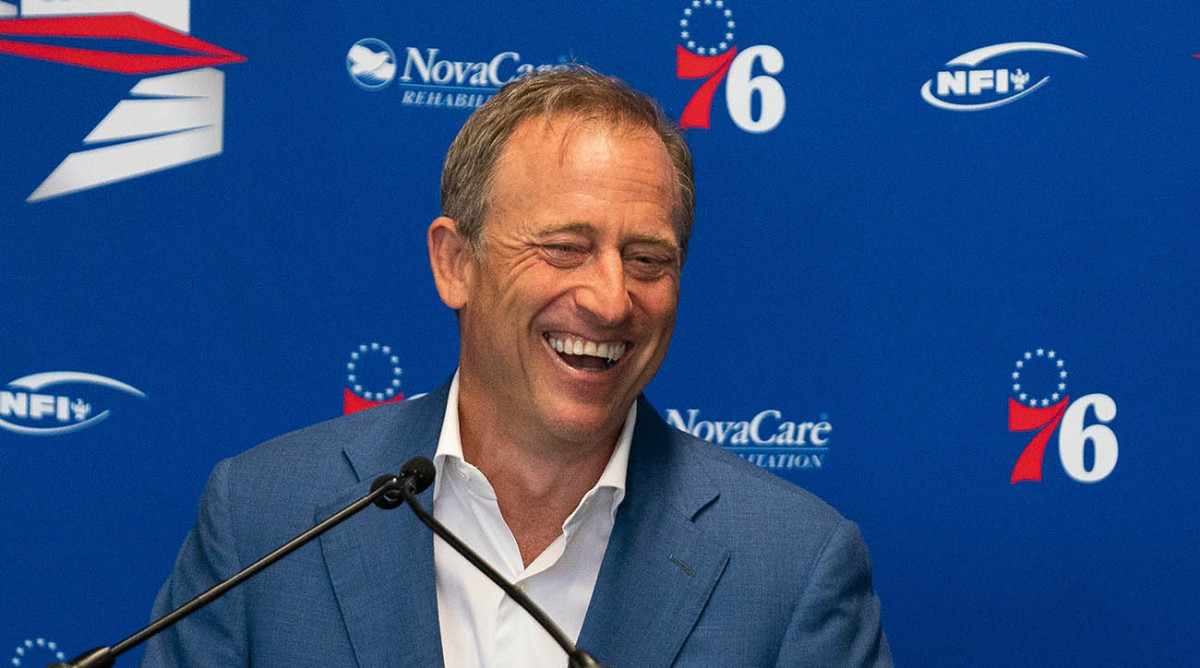Why Lamar Jackson’s Deal Is a Step Up From Jalen Hurts’s

Now that you’re done with the inside story of Aaron Rodgers’s trade negotiation and the six players fans need to know in the 2024 draft, here are my takeaways as we enter a slower time in the NFL calendar …
The Lamar Jackson deal is evolutionary, not revolutionary. And the side-by-side of his deal and the deal Jalen Hurts did bears that out, with the caveat that Hurts’s deal was an extension (and folded $1.43 million in cash due for 2023 in with five new years), whereas Jackson’s deal was done from scratch (almost without regard for the franchise tag total).
• The first three years (over $106 million) in Hurts’s deal are fully guaranteed now, as are the first three years of Lamar Jackson’s deal ($156 million). That takes both through 2025.
• Jackson’s getting $52 million in 2026, and $29 million of that will become fully guaranteed in March ’25. Likewise, Hurts is due $51 million in ’26, and nearly $50 million of it will be fully guaranteed by March ’25.
• Jackson’s money for 2027 doesn’t vest early. A piece of Hurts’s money for ’27 does: $22 million of the $51 million in cash he’s owed that year. Conversely, in the four years leading up to ’27, Jackson will have made $208 million, while Hurts will have earned $157.3 million (excluding escalators) at that point.

• Jackson has a freeway to free agency after 2027, with no-tag and no-trade clauses. Hurts is signed through ’28 and has a no-trade clause, but not a no-tag clause. So where Hurts’s guarantees last a year longer than Jackson’s, Jackson is up (without restriction) a year earlier.
• Jackson had more leverage than Hurts, with his contract having expired, his career earnings at nearly $33 million and a $32.42 million tag to play on, had negotiations failed again. Hurts was under contract for 2023, with about $4.59 million in career earnings, and a low number in front of him on his rookie contract for this fall.
If all the numbers haven’t made your eyes glaze over yet, here’s the overarching point: Jackson wound up doing a deal that’s part of the quarterback-contract assembly line. Kyler Murray’s deal was a tick up from Josh Allen’s deal. Russell Wilson’s was a tick up from Murray’s. Hurts’s was a tick up from Wilson’s, and now Jackson’s is a tick up from Hurts’s.
So on one hand, the Ravens did win. Their offer last season was a five-year extension through 2027 that had $133 fully guaranteed at signing, a $175 million injury guarantee and another $25 million on top of that in ’26 that will vest in early ’25. The full guarantee ($135 million) and injury guarantee ($185 million) on the deal he just did are better, but not by a ton. And there are nonguaranteed years (de facto team options) at the end.
On the other hand, Jackson did walk away with wins. One of his counterproposals was a fully guaranteed, three-year, $156 million deal. The cashflow on the first three years of his deal? One-hundred-and-fifty-six million, with $135 million fully guaranteed, and the rest guaranteed next March. And, really, that leads you in the important parts of the deal.
The cash flow here—$80 million through one year, $112.5 million through two, $156 million through three, $208 million through four and a $260 million total over five—is really strong. There also isn’t a great exit ramp on this deal for the team in its final year. Cutting Jackson after two years would mean (minus offsets) paying him $156 million ($78 million per year). Doing it after three years would mean paying him $185 million (nearly $62 million per).
Which, in the end, illustrates why Jackson had to do this—with the leverage that teams have over quarterbacks in the negotiations, and knowing that the quarterbacks really are the only ones with the leverage to change the way NFL contracts are written (by setting precedents on guaranteed money). If you’re Jackson, principles aside, you can say no to this sort of money only so many times before the time comes to just take the bag.
And I say that with the full acknowledgement that Jackson even taking it this far showed a lot of guts and a good bit of discipline, too.
While we’re on Lamar, he delivered a zinger of a quote the other day. This one was in response to a question on the Ravens’ adding Zay Flowers and Odell Beckham Jr. to their arsenal, which was met with a laugh from the quarterback.
“I want to throw for like 6,000 yards with the weapons we have,” Jackson said. “I'm not an individual-award-type guy or a stat watcher. I just want to do that because no one has ever done it and I feel like we have the weapons to do it.”
Based on Jackson’s strengths, and the Ravens’ run game’s strength, I don’t see that happening. That said, John Harbaugh clearly didn’t hire Todd Monken from Georgia simply to take what Greg Roman built for Jackson over the last four years and create the next iteration of it.
Monken’s last year as a play-caller in the NFL was with the Buccaneers in 2018. That year, Tampa Bay, with Jameis Winston and Ryan Fitzpatrick as its signal-callers, led the NFL with 5,358 passing yards. The Bucs were fourth in pass attempts (625), while ranking in the bottom third of the league in rushing attempts (389), with the third-worst yards-per-rush average in the NFL. And at traditionally run-heavy Georgia, Monken revolutionized the Bulldogs’ passing game: Last year, Monken’s unit was ranked top 20 nationally in pass attempts. (They were also top 20 in rush attempts, which speaks to how good the team was in ’22.)
Now, Monken is very well-respected in football circles for his creativity, and with move-around pieces such as Flowers, Beckham, Mark Andrews and Isaiah Likely, he has the components to unlock the potential of Baltimore’s improved personnel. And because of that creativity, you’ll see Monken’s flexibility to work with what he has (which is to say he won’t be shoving square pegs into round holes).
Still, if you add it up, with the knowledge that Jackson’s been talking to Monken and has the playbook, it’s easy to see where the quarterback’s words may have been a little more than an off-hand comment in a news conference. Even if 6,000 yards isn’t happening.
With the draft in the rearview mirror, I figured I’d ask a few scouting directors for their takeaways from the big weekend. Here’s a sampling of a few texts I got back Sunday …
• From an AFC exec: “Unpredictable first round. Some teams who don’t value high-level character have found a way to manage the guys with suspect off-field behavior and are not afraid to take risks (Chiefs). Gambles have paid off, so this year was no different. Some teams have failed (Raiders), so they took a high volume of team captains with high-level traits this year to change the culture of the locker room. Also, most QB boards from around the league were completely cleared after the first 40 picks, so it will be interesting to see where a mid-round hit will possibly come from.”
• From an NFC exec: “I think everyone wanted to see how those quarterbacks at the top shook out—just for curiosity’s sake and entertainment value in how desperate teams might get. In general, I honestly didn’t feel like there were names after the second round to get pumped about being there, like there would be in most drafts. Rest of the draft felt like trade-back mode because of that.”
• From a second AFC exec: “It’s still all about the quarterback. One, despite all the projections, when you don’t have one, you have to try to find one, so three of the projected top four QBs went in the top four. Two, in the top 10, if you take out the QBs, of the seven other players, three were rushers to get the quarterback down on the ground and two were OTs to keep the QB protected, and those two teams have younger-ascending QBs in Arizona and Chicago. And if you expand that review into the top 15—two more protectors of the QB were taken (Peter Skoronski/Broderick Jones), and two more rushers were taken (Lukas Van Ness/Will McDonald IV). It all revolves around the quarterback.”

And with that established, the Bills’ pick of Dalton Kincaid might’ve been my favorite of the first round—both for how it’ll help the team (we’ll get to that in a second) and how it happened. How it happened, specifically, only reinforces how important relationships are in the NFL, in the way these things have to come together on the fly.
The Bills figured going into that Thursday night that they may be out of first-round-graded players by the time they got on the clock at 27. But to cover his bases, GM Brandon Beane called his old top lieutenant, Giants GM Joe Schoen, to feel him out on a trade up, if certain players made it to New York’s turn at 25. Schoen told Beane he might also be interested in going up if things fell a certain way on his board. But in case they didn’t, the two worked out agreeable parameters on a potential trade.
Beane, like a lot of other NFL GMs, thought Kincaid would probably go 13th or 21st, to Green Bay or the Chargers. So when the Chargers took Quentin Johnston at No. 21, Beane texted Schoen to see if they were on for the trade. Schoen responded he wanted to wait and see how the next couple of picks fell, but he’d be in touch. And from there, the run on receivers continued, with Zay Flowers going to the Ravens at No. 22 and Jordan Addison going to the Vikings at No. 23. Then, with the Jaguars on the clock, Schoen got back to Beane—he was trading up, flipping picks with Jacksonville, to get Maryland corner Deonte Banks.
That was a couple of minutes before the league announced the trade to the teams (and well ahead of the broadcast), which gave Beane an early opening to call Jaguars GM Trent Baalke. With the feeling Dallas would take Kincaid at No. 26, Beane felt like he’d either have to trade with Jacksonville to get the Utah star or lose him. So he reached out.
You’re gonna have to tell me who you’re taking, Baalke said to Beane.
Beane was coy. Baalke asked whether it was offense or defense; Beane said offense. He then asked whether it was a big guy or a small guy; Beane said medium. It’s not a lineman? Baalke asked. Beane assured him it wasn’t one, then conceded it’d be a tight end. Baalke told him he wanted first to see who Schoen would pick. The Banks pick was announced, and Beane called Baalke back.
Beane said on the draft value chart, the 137th pick would be a fair price to go up. Baalke said Beane needed to do better than that, because he was taking a risk. Beane said he’d give him the 130th pick instead, and it was done. Kincaid was a Bill, and Baalke got the lineman he wanted at 27 in Oklahoma tackle Anton Harrison. Had the trade fallen through and Kincaid gone to Dallas? Beane had potential trades lined up with three teams (Tennessee was one) to trade out of the first round and into the top of the second.
So as for what the Bills saw in Kincaid: They wanted to find a mismatch player, be it a receiver or tight end, in the first couple of rounds and had a handful they thought might be available to them over the draft’s first two nights. In their playoff exit, the Bills watched the Bengals bracket and double Stefon Diggs, and they knew they needed more ways to make defenses pay for that approach.
Kincaid showed on tape he could be that type of weapon over the middle of the field. He was instinctive and smart enough to snuff out man vs. zone coverage—and react to it—quickly, something that’s essential to winning in an area where things happen fast. That’d help Josh Allen, too, in giving him a weapon who could react in hot situations against blitz looks, and in giving the Bills a complement to Dawson Knox, who’s grown into a very solid blocker (he wasn’t so much coming out) as a traditional “Y” tight end.
The Bills got that vision for Kincaid relatively quickly, too. They chose not to bring him in for a 30 visit, having gotten enough from the combine in Indianapolis through medical-grade sharing with other teams (Kincaid had a back issue) and in a few Zoom meetings with coaches. And that vision, of another player, such as scatback James Cook, who could be a bad matchup on a linebacker and contribute in the run game if the opponent flooded the field with defensive backs, is now real for Buffalo.
Thanks, in no small part, to the relationships GMs build with their peers over the years.
The Jordan Love deal is fair for everyone. We took you through the on-field reasons why the Packers were ready to turn the page from Rodgers to Love this offseason. And Green Bay negotiated a deal that shows how the franchise feels about Love, even if it does hedge the bet it’s taking on him a bit.
Love was due $2.29 million this year. On the new deal, he gets a $8.789 million signing bonus and a $1.01 million base. That means he nearly quadrupled his pay for 2023.
Packer Central: Packers Will Not Re-Sign Marcedes Lewis
If he plays really well, a couple of things will happen. One, his 2024 cash will jump from $6 million and could go all the way to $15 million. Two, the Packers will probably try to negotiate a long-term deal to keep him in Green Bay, which would mean the extra $7.5 million he’s getting in ’23 becomes a nice bonus he wouldn’t have otherwise seen. So in that sense, Love is betting on himself in doing the deal—he could’ve rolled the dice and forced the team to exercise the $20.27 million option for ’24, which wouldn’t bring the ’23 benefit.
And if Love doesn’t play well, yes, the Packers get an escape hatch. Hitting any of the escalators for 2024 will require Love being a top-half-of-the-NFL quarterback in ’23. Hitting all of them will mean he’s become a great one—and require the deal being ripped up anyway. If he bombs, the Packers could be responsible for as little as $6 million next year, which would be like paying backup (and which would allow them to add a new starter).
So all in all, this was a good, creative way to create benefits for both sides.

I love that Giants GM Joe Schoen has shown the willingness to pay guys that he inherited. This week provided a great example of it with the four-year, $90 million extension the team did with defensive anchor Dexter Lawrence. But it certainly wasn’t the first one. Schoen and Brian Daboll also went the distance to get Daniel Jones signed (despite declining his fifth-year option the year before), are working to get Saquon Barkley done and just picked up Andrew Thomas’s option for ’24 (with a long-term deal likely at some point).
My guess is we’ll see, down the line, a couple of other examples pop up, too. If they can stay healthy this year, safety Xavier McKinney and edge rusher Azeez Ojulari could be two.
The crux of all of it, to me, is where most folks thought the roster needed a total rebuild—and I’d say to a degree Schoen and Daboll agreed with that—the coach and GM came in last year with an open mind to what Dave Gettleman and Joe Judge left behind for them. It led to a bunch of revelations that’ll help the two in building the team for the long run.
“Dabs and I really don’t worry about where the players came from or how they arrived in New York,” Schoen told me, via text, Sunday. “Players will always compete for their jobs, regardless of salary or draft position. We are fortunate that there were some good players on the roster that fit what we were looking for. Our goal will always be to acquire and retain good football players that fit our culture.”
Of course, Daboll and his staff deserve credit, too, for mining talent from a roster that had been seen as fundamentally broken no more than nine months ago. In fact, it’d be hard to argue that hasn’t been a pretty major reason why the rebuild is so far ahead of schedule.
The left tackle/right tackle thing has caused problems this offseason. It’s a big reason why the market for Orlando Brown Jr. didn’t materialize as he’d hoped in March—he wanted no part in going back to right tackle, a stance that precipitated his departure from Baltimore two offseasons ago. It was also the source of some back-and-forth between Jets coach Robert Saleh and star-crossed 2020 first-round pick Mekhi Becton last week.
And it was a big factor in Jonah Williams’s trade request at the start of free agency, after he was caught off-guard by the Bengals’ signing of Brown. Now, Williams is still rehabbing from knee surgery in California, should be cleared for football activity before training camp and will likely be a Bengal in 2023. But the prospect of having to flip sides soured the only professional home he’s ever known.
So why all the acrimony? Well, left tackle isn’t just the glamor position of the offensive line, it’s also where a guy is most likely to make the most money. Here are the NFL’s 10 highest paid tackles ….
1. Laremy Tunsil, Texans: $25.00 million APY.
2. Trent Williams, 49ers: $23.01 million APY.
3. David Bakhtiari, Packers: $23.00 million APY.
4. Lane Johnson, Eagles: $20.19 million APY.
5. Jawaan Taylor, Chiefs, $20.00 million APY.
6. Ronnie Stanley, Ravens: $19.75 million APY.
7. Ryan Ramczyk, Saints : $19.20 million APY.
8. Brian O’Neill, Vikings: $18.5 million APY.
9. Jake Matthews, Falcons: $18.33 million APY.
T-10. Kolton Miller, Raiders: $18.00 million APY.
T-10. Cam Robinson, Jaguars: $18.00 million APY.
Count it up, and seven of those 11 players play on the left side, with an eighth, Taylor, having been signed with the idea, from his new team, that he’d be able to switch over to left tackle. Of the 25 highest-paid tackles, if you include Taylor in the group, 18 play on the left.
So teams can say what they want about right tackles being just as important. Players can say it’s about comfort level. The truth? This trend, like most others, is about money.
The Chiefs’ move for Donovan Smith last week is another example of Kansas City really firing on all cylinders. Why? Well, because we had Smith on the team’s radar all the way back on March 7, and he’s stayed there since as a sort of contingency target with the team in the midst of reworking its tackle position.
The first domino, of course, was Jawaan Taylor coming in on a four-year, $80 million deal, as the Chiefs let Orlando Brown Jr. go to the market. Taylor was signed to play left tackle. But with the team also losing its right tackle—Andrew Wylie got a nice payday in Washington—what Kansas City really valued in Taylor was his position flexibility, where the Chiefs could add either a left or right tackle later in the offseason,and fit its new cornerstone at the position in around whoever’s at that addition.
Smith was on the Chiefs’ radar at that point, pending how the draft went. My feeling is had Jacksonville not taken Harrison at 27, the Chiefs would’ve grabbed him at 31 and slotted him in as their left tackle, with Taylor going to the right side. Without Harrison, Kansas City actually wound up with his Oklahoma bookend, Wanya Morris, in the third round. And while they like Morris, it’d be much tougher to count on him to start as a rookie than it would’ve been with Harrison. Hence, the move to acquire Smith, whose biggest question may be how motivated he’ll be (playing for a title contender should help there) on a one-year deal at $4 million, with upside to $9 million.
So maybe it’ll be Taylor at left tackle and Morris at right tackle. Maybe it’ll be Smith at left tackle and Taylor at right tackle. Either way, the Chiefs generated multiple options (with Lucas Niang still in the mix, too), and multiple pathways to long-term answers at the position (with the possibility Smith will start and Morris will develop behind him, or Niang will emerge as part of that), after having two guys starting at those spots in contract years last year.
Oh, and the other thing? Smith going there on the cheap is another example of the Chiefs’ having an advantage on, really, almost everyone, in that they can get good deals on veteran players looking to chase a ring.

There are two things to keep watch for this week, with the sleepy part of the NFL calendar upon us. One is, of course, the schedule release, and we plan on having some fun content on the site when it’s announced. The other is the NFL having committee meetings this week in New York City.
Those meetings are regularly scheduled meetings that happen ahead of the league’s spring meeting (which kicks off two weeks from Monday in suburban Minneapolis). But they could be significant, with the finance committee meeting as part of that and the sale of the Commanders reaching its final stages.
Before the sale, presumably to billionaire Josh Harris’s group, goes to the full body of NFL owners, its structure has to be fully vetted and approved by the finance committee. This week provides the opportunity for that to happen in time for the owners to vote on Harris’s bid in a couple of weeks at the spring meeting. So we could well have some major steps taken over the next few days, which of course would be great news for all the folks in D.C. who have been waiting a couple of decades for Dan Snyder’s outster from the ranks of NFL owners.
For what it’s worth, the agenda for this week’s meetings hasn’t gone to teams yet, but there’s an assumption that the Commanders will be on the finance committee’s plate on Wednesday or Thursday.
